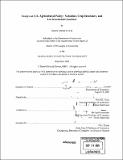| dc.contributor.advisor | David H. Autor and Michael Greenstone. | en_US |
| dc.contributor.author | Kirwan, Barrett E., 1974- | en_US |
| dc.contributor.other | Massachusetts Institute of Technology. Dept. of Economics. | en_US |
| dc.date.accessioned | 2007-08-03T15:35:33Z | |
| dc.date.available | 2007-08-03T15:35:33Z | |
| dc.date.copyright | 2005 | en_US |
| dc.date.issued | 2005 | en_US |
| dc.identifier.uri | http://dspace.mit.edu/handle/1721.1/33831 | en_US |
| dc.identifier.uri | http://hdl.handle.net/1721.1/33831 | |
| dc.description | Thesis (Ph. D.)--Massachusetts Institute of Technology, Dept. of Economics, 2005. | en_US |
| dc.description | Includes bibliographical references. | en_US |
| dc.description.abstract | This thesis investigates the unintended consequences of government policy, specifically policy meant to benefit agricultural producers. The first chapter asks how agricultural subsidies affect farmland rental rates. Chapter two examines the relative effects of ad hoc disaster payments and crop insurance, focusing on the potential to smooth income shocks, and the final chapter studies the targeting efficiency of the Conservation Reserve Program. Chapter one exploits exogenous variation in agricultural subsidies to measure the effects on farmland rental rates. The primary finding is that landlords capture one-fifth of the marginal subsidy dollar per acre. This finding stands in contrast to the standard assumption that landlords immediately capture the entire subsidy. There is some evidence that the share of the subsidy captured by landlords increases as the farmland rental market becomes more competitive. The analysis also indicates that the lower effective price of land induces tenants to rent more land such that they gain roughly $1 per dollar of subsidy. Taken together, the results suggest that agricultural subsidies benefit farmers, as well as individuals that own agricultural land. Chapter two exploits random weather variation and exogenous variation in crop insurance take-up in order to investigate the relative effect of two forms of government-provided disaster relief on farm failure rates. | en_US |
| dc.description.abstract | (cont.) I find that disaster relief in the form of ad hoc disaster payments slightly reduces the average farm failure rate, while average farm failure rates increase under a crop insurance regime. The relative effect suggests that farm failure rates increase by 1.7 percentage points (about 30-percent) under the crop insurance regime. Excessively generous ad hoc disaster payments and moral hazard provide possible explanations for these findings. These findings suggest that government-provided crop insurance plays an important role in farmer risk management. Chapter three estimates the premiums received by Conservation Reserve Program participants above their reservation rents. Findings suggest that participants receive substantial premiums, and the premiums have increased over time as uncertainty about the program has decreased. | en_US |
| dc.description.statementofresponsibility | by Barrett Edward Kirwan. | en_US |
| dc.format.extent | 124 p. | en_US |
| dc.language.iso | eng | en_US |
| dc.publisher | Massachusetts Institute of Technology | en_US |
| dc.rights | M.I.T. theses are protected by copyright. They may be viewed from this source for any purpose, but reproduction or distribution in any format is prohibited without written permission. See provided URL for inquiries about permission. | en_US |
| dc.rights.uri | http://dspace.mit.edu/handle/1721.1/33831 | en_US |
| dc.rights.uri | http://dspace.mit.edu/handle/1721.1/7582 | |
| dc.subject | Economics. | en_US |
| dc.title | Essays on U.S. agricultural policy : subsidies, crop insurance, and environmental auctions | en_US |
| dc.title.alternative | Essays on United States agricultural policy : subsidies, crop insurance, and environmental auctions | en_US |
| dc.type | Thesis | en_US |
| dc.description.degree | Ph.D. | en_US |
| dc.contributor.department | Massachusetts Institute of Technology. Department of Economics | |
| dc.identifier.oclc | 65198872 | en_US |
